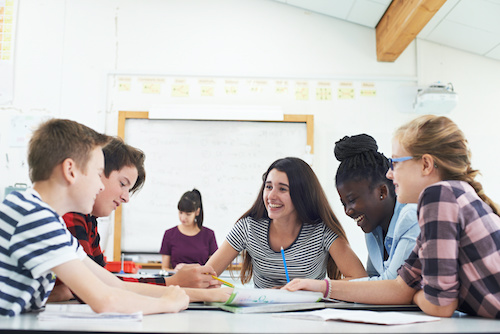
What’s the Big Deal About SEL in High School?
5 Easy Strategies Educators Can Use Every Day to Help Students Thrive
Adolescence is a time of intense change. Hormones released during puberty not only cause visible physical changes but also trigger an intense period of brain plasticity, or the ability of the brain to grow and reorganize based on experience.
Because of these brain changes, adolescents and their parents navigate challenges even during the best of times—and it has not been the best of times. The US is facing a mental health crisis worsened by the COVID-19 pandemic. Recent research from the CDC reports that over half of teenage girls and nearly a third of teenage boys feel persistently sad or hopeless. Even more alarming, mental health issues that show up during adolescence may be more likely to get “wired” into the brain: 50 percent of lifetime mental health conditions begin by age 14 and 75 percent by 24.
These statistics show why it’s more important than ever for educators and families to invest in the well-being of adolescents. Helping teens build life skills through social-emotional learning (SEL) is an effective way to protect their mental wellness and give them tools to thrive in and out of school.
The good news is that creating opportunities for SEL is more accessible than many educators realize. My time as a longtime educator and a researcher at one of the nation’s leading SEL nonprofit organizations has shown me that you don’t have to have dedicated SEL time or be an SEL expert to help teenagers build resilience, empathy, and other critical social-emotional skills.
Here are some easy ways educators can integrate SEL into the classroom every day:
1. Cultivate belonging
When students feel a sense of belonging and community at school, they tend to experience less psychological distress, become more engaged and motivated, and achieve better academic outcomes. Adult connections are essential for adolescent development and a sense of belonging; educators can help address this and cultivate feelings of belonging through relationship-building.
Try this:
- Tell each student something you appreciate about them.
- Map positive connections between students and educators and be sure every student has at least one caring adult checking in with them.
- Share your personal experience. Showing appropriate and healthy levels of vulnerability can lead to deeper relationships with students.
2. Build hope and optimism.
Expecting positive outcomes can increase well-being, motivation, and willingness to persist in facing challenges and goal attainment. Hope and optimism skills and mindsets can benefit high school students preparing for their next steps in life.
Try this:
- Create space and time for students to envision possible positive futures for themselves.
- Encourage students to challenge negative thoughts about themselves and their experiences.
- Share stories of people who have successfully overcome challenges–especially those who share aspects of your students’ identities.
3. Create opportunities for mastery experiences.
When students have a high sense of self-efficacy—belief in their ability to achieve an outcome or reach a goal—they are more likely to engage, stay motivated, and achieve better academic results. Students can develop self-efficacy by trying, persisting, and succeeding at new challenges. In other words, when they have mastery experiences by successfully completing a challenging task or overcoming a difficulty.
Try this:
- Help students identify their most important goals and create action plans with multiple pathways to reach them.
- Create opportunities for students to engage in the intention-action-reflection cycle through goal-setting, taking action, and reflecting on the results.
- Create a culture where mistakes and failures are celebrated as a part of learning.
4. Notice, celebrate, and build on students’ strengths.
Knowing and using your strengths (rather than focusing on fixing flaws) has been found to increase well-being, relieve depression, and increase happiness. Seeing and acknowledging students’ strengths can contribute to a number of positive academic outcomes, including high satisfaction, higher grades, increased motivation, effort, and achievement, lower behavioral issues, and positive school adjustment during transitions.
Try this:
- Create a daily practice of emphasizing strengths you observe in students.
- Create time and space for students to learn about their strengths and help them consider how to use them in their lives.
- Create classroom routines for students to identify others using strengths with positive outcomes.
5. Incorporate moments of fun and laughter.
Laughter can have some profound benefits. Experiencing positive emotions can improve health, improve resilience, and increase academic performance.
Try this:
- Start each class period by sharing a joke or a joy.
- Regularly ask students to reflect on positive moments from their day or week.
- Craft opportunities for students to envision and anticipate positive outcomes on their efforts, projects, and goals.
Adolescence is a high-impact time for social-emotional learning. Because brain plasticity is highest in early childhood and adolescence, the experiences teenagers have today can shape their brains for a lifetime. By integrating SEL into all parts of the high school day, educators can take advantage of this growth stage by helping students build the social-emotional competencies to strengthen their well-being today and protect it in the future.